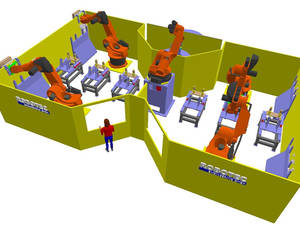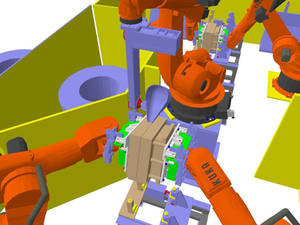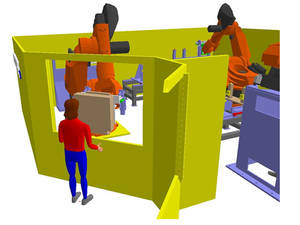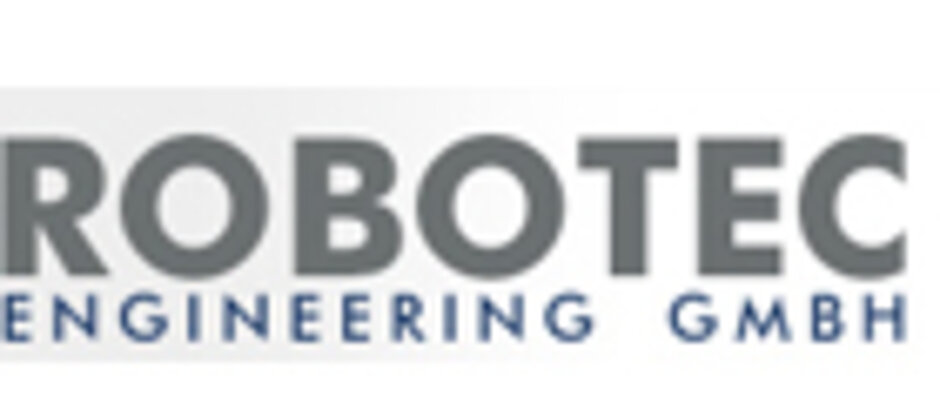ROBOTEC Engineering GmbH from Bad Säckingen presents a robot-based gravity die casting system at GIFA.
From the very beginning, the specifications for the proposed innovation included reduced plant engineering together with increased productivity and greater flexibility for higher quality. ROBOTEC Engineering GmbH, the development company and plant engineer based in south-west Germany, has named its plant concept RoboMold and wishes to introduce it to the specialist public at GIFA in Düsseldorf from 12 to 16 June 2007.
Innovative, flexible, efficient and productive! According to ROBOTEC developers, whoever is looking for such “employees” (and these days, who isn’t) should take a close look at the plant concept of an innovative robotic gravity die casting system. Such a system is being introduced to the public for the first time by the Bad Säckingen-based company at the forthcoming GIFA in Düsseldorf. Experts believe that the concept, with the new and unusual plant layout, takes gravity die casting to a new level. With much shorter cycle times and an overlapping mode of operation, there is an increase in the output of cast parts at the same time as a reduction in the amount of materials used and greater structural quality. Five robots with six dies operate in two production cells each in an intelligently coordinated process and, according to calculations by automation specialists from south-west Germany, thus guarantee the much greater efficiency of the entire casting process.
 <link file:7281> |
“Because we are convinced that this plant sets new standards, we will launch this concept on the market under its own brand name”, states Joachim Rotzinger in the run-up to GIFA. Under the “RoboMold” label, the young company, located near the Swiss border, wants to impress experts with its idea for a new gravity die casting foundry. This idea appears as obvious as it is simple: Joachim Rotzinger and Heinz Nitsch, together with their team, have utilised the possibility of using ever more complex motion sequences, at the same time as increasing both the load rating and stability of the robots. The dies are now located where the grippers are usually attached to the robots’ arms. “With work processes that have been defined with maximum precision and that are coordinated throughout the overall process, the robots can be used for highly effective production”, emphasises Joachim Rotzinger. There is a high degree of automation. The five industrial robots are arranged in two available. There is a maintained die on hold for each cell in a change station. As in metalworking, where the drill is changed before it becomes blunt, RoboMold can change its tools preventatively and thus create optimum casting parameters – this guarantees high plant availability due to fewer downtimes whilst consistently maintaining the highest possible quality. The FlexCast casting robot arranged in the centre for a maximum casting weight of 25 kg loads the dies in a carefully defined cycle time that is no longer dependent on the cooling time of the cast part with the longest solidification time, rather on the shortest possible change rhythm of the whole process. “It’s real music to the ears”, says Heinz Nitsch, who believes that this will result in economic advantages in particular.
However, robotic die handling offers more than process engineering advantages. “The fact that we are able to use the robots to manipulate the dies in any direction during filling and during the solidification time was the driving force behind the idea for RoboMold”, emphasises Joachim Rotzinger at this point. For about two years, it has also been possible to synchronise robots and this has given rise to new opportunities. For example, feeding of the dies can be optimised: the lower cycle volume or smaller feed volume as a result of the subsequent aligned solidification position ensures a clear reduction in the amount of materials used. During the material solidification, the free movement of the dies enables gravity-feeding. As a result, the structural density is very high.
The innovative casting method, which involves each die-half being moved by a robot, means that the dies are freely available for further activity. The technical advantages are thus manifest throughout the process as a whole: automatic die change is possible, as is the free setting of the cores (manual + automatic). However, the fact that the dies are both easy to clean and easy to blacken results in further advantages in terms of both time and handling. Not least because further processing stages to the cast part are possible, provided that the cast part is still located in the die: the removal of the sprue and feeder or bore and milling operations can be linked to the casting process. Depending on the respective application, the connection of an additional processing robot via the extremely accurate positioning of the handling robot certainly makes good sense.“As is always the case, technical advances and process-management optimisations result in further economic advantages”, says Heinz Nitsch in summary. So what does this mean? To give just one example: the die does not have to be heated for such a long time, since the cast part is removed immediately after its specific solidification time, thus resulting in much lower energy costs. However, both the Finance and Controlling Departments are also pleased about the lower investment costs, minimum space requirements and low plant costs that arise as a result of the use of standard components.
By launching RoboMold, ROBOTEC Engineering GmbH wishes once again to draw attention to its excellent performance as a highly specialised company in the field of casting automation. “On the one hand, we regard the ongoing innovation and our activity at the forefront of technology as a tremendous challenge and, on the other hand, this also reflects the claim that our company is pursuing”, say Joachim Rotzinger and Heinz Nitsch in unison. The fact that ROBOTEC systems are now used by almost all high-profile German automotive manufacturers appears to confirm the ambitious route that the company has embarked upon.
RoboMold facts and figures:
RoboMold – the innovative system concept for the gravity die casting foundry. Robots ensure greater efficiency. The technical features at a glance:
- Robotic casting system with 5 cooperating robots for high-quality gravity die casting
- Cycle times 30 seconds per die (depending on the solidification time, with 6 dies in the system)
- Die dimensions (WxHxD) 1000 x 600 x 250 per half, weight max. 350 kg per half
- Casting weights up to 25 kg
- Preventive die changing < 45 seconds creates high plant availability and uniform quality
- Better feeding of cast parts (= higher quality) and less material in the cycle (= lower energy costs, shorter solidification time) as a result of aligned stop position
- High availability and low investment volume of the plant, thanks to the use of standard industrial robots
 <link file:7282> |  <link file:7283> |
| It’s all possible thanks to intelligent control: cooperating robots during casting | Hand in hand: employee setting the core in the die |
Contact to <link _top>ROBOTEC Engineering GmbH in our Suppliers Profile


